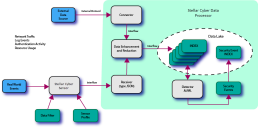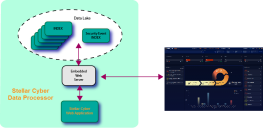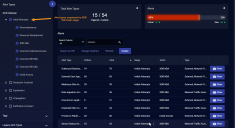Stellar Cyber Architecture
Stellar Cyber is a unified platform for Security Operations, providing a central location to gather and organize security threat information by unifying together key data, tools and alerts for analysis. Stellar Cyber also automates both threat detection (using AI and machine learning) and response (using automated threat hunting). This helps reduce the noise so you aren't overwhelmed by the amount of information and can find and focus on the real threats. You can even teach the machine learning to present only the information that truly interests you.
High Level View
The essential first step in implementing security is to gather information. The following figure shows the conceptual model and components that Stellar Cyber uses in the collection phase.
As with any monitoring system the data flow starts with real-world events. The following explains the functions and roles of each major element in the diagram.
- Stellar Cyber Sensor: There can be any number of sensors in the network. There are also different types of sensors as described in the sections below. Regardless of the type the basic function is the same: When observed events occur, the sensor generates Interflow records and sends them to a receiver. Sensors are discussed in greater detail in a section below.
- Receiver: This is a task running in the DP that passively listens for input from sensors. There can be any number of receivers instantiated in the system and each one may serve any number of sensors. There are currently two types of receivers: packet and JSON. The JSON form is used to process Interflow records from sensors. It defines the IP address and port number that sensors use to connect to the DP. The packet form of receiver (not shown in the figure above) is used to receive raw network packet data from a security sensor.
- Connector: Similar to a receiver, except that it's active, a connector is also a software task. It actively collects information from an external data source and generates Interflow records. There can be any number of connectors configured but one is required for each external data source. There are several different types of connectors, each developed for a different type of data source. Connectors are discussed in a section below in greater detail.
- Data Lake and Indices: The Data Lake is the repository of the information that Stellar Cyber stores. The data is organized into indices, which are categories that Stellar Cyber uses to group data. The indices help make searching much more efficient and effective. An index that stores information directly from the sensors or collectors is referred to as a "raw" index. The security index contains enhanced data based on data from one or more of the raw indices.
- Machine Learning: Stellar Cyber uses machine learning and AI to examine the records in the Data Lake and make a determination of whether it sees evidence of a security breach. When breaches are detected, Stellar Cyber generates alerts. Alerts are reported in the Alerts page and the home dashboard. In addition, Stellar Cyber stores alert records in a special index. There are many different types of machine learning algorithms, each programmed to look for a different class or type of threat.
Together, these components collect information and store it in the Data Lake on a continuous basis, organized in a form suitable for security breach detection.
User Interface
The DP runs an embedded web server that any browser with sufficient capability can use. The system supports any number of connections on the standard TCP ports for the https protocol.
After the initial download of the JavaScript application, all further communication with the DP consists of REST API calls to fetch data and issue commands. The REST API is proprietary.
Interflow
Interflow is the record format used by Stellar Cyber to represent raw data, events, and anomalies. On the network, Interflow is expressed as a JSON object (sometimes referred to as a "hash") that can contain a large variety of keys. The values stored by each key can be any form of object (string, number, or other object).
The Event Display component can display the Interflow record in either tabular or raw JSON form. A key purpose of the Interflow record is to provide evidence for an event of interest. The extensible nature of the Interflow record is used by Stellar Cyber to implement its data enhancement and machine learning (ML) functions. The ability to add fields during its life cycle is also used to adapt connectors that contain new definitions. As a result Interflow is future-proofed and able to handle new requirements when needed.
Although the names of the keys are largely intuitive for security analysts, a dictionary of the Interflow keys can be found on its own Interflow page. The Interflow Dictionary function on the Threat Hunting screen also provides a list of Interflow keys to choose from when searching for threats in the Data Lake. The list of keys will evolve with new versions of Stellar Cyber.
Sensors
Sensors are the components that collect information from key points in the monitored network, compose Interflow records, and send them to the DP. There are several different types of sensors, each with different capabilities and suited for individual environments. The types include the following:
- Linux Agent Sensor—This agent runs within a compatible Linux distribution environment. It is usually configured with a preset maximum amount of resources it can use (for example, no more than 5% of CPU resource) and can collect many different types of information including logs and command execution events.
- Windows Agent Sensor—This agent runs within the Windows environment. The current version exclusively looks at Windows events supported by the Microsoft-defined APIs. Many different threats can be observed from this interface.
- Network Sensor—A network sensor is dedicated to collecting network packets and compiling them into Interflow records to be sent to a receiver.
- Security Sensor—This type of sensor has the capabilities of a network sensor with additional security features integrated, including IDS and sandboxing. A security sensor can also send packet data to the DP.
Although all sensors are ultimately software components that can be run in compatible hosts and hypervisor environments, they can also be packaged in purpose-built hardware for convenience in deployment.
Sensors capture data via the following methods:
- Port mirrors
- Network taps
- Virtual network taps
- Agents
- VXLAN
- GRE
- Logs
- Netflow/IPFIX
Sensors are automatically recognized by Stellar Cyber when they are installed and programmed with the IP address of the DP (this is referred to as the CM, or Configuration Manager, by the sensor). Once recognized, the sensor must be authorized by the Stellar Cyber Configuration Manager. The process of authorization assigns a license to the sensor. See the Sensor Overview page to see how this is done and for links to how you configure sensors, sensor profiles, and filters.
To see which alert types you can get with each sensor, refer the Stellar Cyber alert coverage page.
Encrypted Traffic
Stellar Cyber does not directly decrypt traffic, but can handle it in multiple ways:
- Deploy agents behind proxies
- Detect applications
- Partner with 3rd party decryption
Deploying Agents Behind Proxies
The Stellar Cyber network sensor doesn't need to decrypt traffic when you deploy it behind your proxy server. The traffic is already decrypted by the proxy server when it gets to the sensor, and the sensor can add user and process context to the traffic.
Detecting Encrypted Applications
If you cannot deploy the sensor behind the proxy servers or you are not using proxy servers, Stellar Cyber network sensors can still identify encrypted applications by analyzing the encrypted traffic patterns and TLS/SSL handshaking.
The sensor extracts useful metadata, such as the server certificate, IP addresses, domain names, session duration, and byte counts from the packet header and TLS/SSL handshaking. The IP addresses are enriched with geo location, threat intelligence, host name, user name, and more, to create rich context for alerts and actions. Our machine learning based network traffic analysis and user behavior analysis apply to the encrypted traffic with the extracted metadata and enriched context. In addition, JA3 fingerprinting is used to identify malware with encrypted traffic.
Partnering with 3rd Party Decryption Tools
Stellar Cyber network sensors work with many 3rd party decryption tools, such as F5 SSL Orchestration and Gigamon VAF, taking the decrypted traffic and analyzing it.
Connectors
As with sensors, connectors are a method of collecting information based on real world events and compiling them into Interflow records directed at the Data Lake. There are several connector categories in Stellar Cyber. For the protocols that are supported by a commercial vendor, each interface is supported for the purpose of enhancing the security of their own services.
Connectors are tasks that run within the DP itself. Each connector class uses a protocol defined by the external data source and requires configuration with IP address and authorization credentials.
Assets
An asset is a server, router, host system that appears in the private network being monitored by Stellar Cyber. Assets are automatically registered in Stellar Cyber by sensors. The information used to identify them include MAC address, IP Address, and host name (if available). They can be de-authorized or ignored by user command if needed. Hosts outside the private network are not considered assets. Using the Asset Analytics screen, the user can examine assets for threat data and also examine performance history.
Alerts
Alerts are a critical component of Stellar Cyber's ability to discover important events in a sea of data. Using ML techniques as well as algorithms developed over long experience, Stellar Cyber examines raw event data for evidence of security breaches. Insignificant events are passed over and sifted for anomalies. When anomalies are found, Stellar Cyber generates alerts that are entered into the Alerts Index and reported in the Stellar Cyber user interface.
Alerts help drive the action in the home dashboard, the Alert Types page, and the Cases interface. Stellar Cyber uses AI to score the alerts to help you prioritize actions and responses.
There are many different types of alerts available in Stellar Cyber, organized by XDR Kill Chain Stage, Tactic, and Technique, with each focused on a specific type of security threat. The figure above shows the organization of the alerts in the Alert Types page.
Cases
Stellar Cyber also leverages ML to correlate disparate alerts into a coalesced case.
A case is a set of multiple correlated alerts and entities constituting a potential unified security attack, ranked by a dynamically updated score indicating the severity of the attack. Stellar Cyber uses its machine-learning capabilities to generate cases automatically, grouping related alerts into a unified case for improved attack resolution.
Stellar Cyber reports cases in the Home dashboard, as well as in the Case Management interface, giving you a powerful tool to organize and respond to security incidents.
Firewall Actions
Stellar Cyber has the capability of interfacing with firewall rules. Once configured, the Stellar Cyber can mitigate security breaches by blocking malicious traffic as soon as it is identified. Two modes supported include:
- You can manually trigger a firewall action from the event display.
- An Automated Threat Hunting Playbook may specify a firewall response to be taken automatically when some condition is met.




